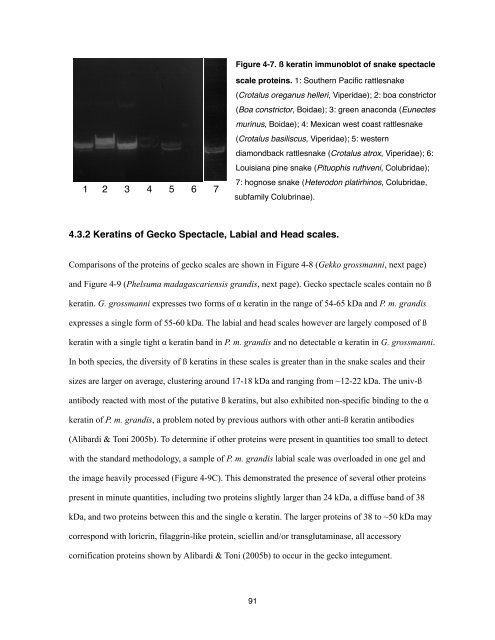Chapter 1, The Reptilian Spectacle - UWSpace - University of ...
Chapter 1, The Reptilian Spectacle - UWSpace - University of ...
Chapter 1, The Reptilian Spectacle - UWSpace - University of ...
Create successful ePaper yourself
Turn your PDF publications into a flip-book with our unique Google optimized e-Paper software.
1 2 3 4 5 6 7<br />
Figure 4-7. ß keratin immunoblot <strong>of</strong> snake spectacle<br />
scale proteins. 1: Southern Pacific rattlesnake<br />
(Crotalus oreganus helleri, Viperidae); 2: boa constrictor<br />
(Boa constrictor, Boidae); 3: green anaconda (Eunectes<br />
murinus, Boidae); 4: Mexican west coast rattlesnake<br />
(Crotalus basiliscus, Viperidae); 5: western<br />
diamondback rattlesnake (Crotalus atrox, Viperidae); 6:<br />
Louisiana pine snake (Pituophis ruthveni, Colubridae);<br />
7: hognose snake (Heterodon platirhinos, Colubridae,<br />
subfamily Colubrinae).<br />
4.3.2 Keratins <strong>of</strong> Gecko <strong>Spectacle</strong>, Labial and Head scales.<br />
Comparisons <strong>of</strong> the proteins <strong>of</strong> gecko scales are shown in Figure 4-8 (Gekko grossmanni, next page)<br />
and Figure 4-9 (Phelsuma madagascariensis grandis, next page). Gecko spectacle scales contain no ß<br />
keratin. G. grossmanni expresses two forms <strong>of</strong> α keratin in the range <strong>of</strong> 54-65 kDa and P. m. grandis<br />
expresses a single form <strong>of</strong> 55-60 kDa. <strong>The</strong> labial and head scales however are largely composed <strong>of</strong> ß<br />
keratin with a single tight α keratin band in P. m. grandis and no detectable α keratin in G. grossmanni.<br />
In both species, the diversity <strong>of</strong> ß keratins in these scales is greater than in the snake scales and their<br />
sizes are larger on average, clustering around 17-18 kDa and ranging from ~12-22 kDa. <strong>The</strong> univ-ß<br />
antibody reacted with most <strong>of</strong> the putative ß keratins, but also exhibited non-specific binding to the α<br />
keratin <strong>of</strong> P. m. grandis, a problem noted by previous authors with other anti-ß keratin antibodies<br />
(Alibardi & Toni 2005b). To determine if other proteins were present in quantities too small to detect<br />
with the standard methodology, a sample <strong>of</strong> P. m. grandis labial scale was overloaded in one gel and<br />
the image heavily processed (Figure 4-9C). This demonstrated the presence <strong>of</strong> several other proteins<br />
present in minute quantities, including two proteins slightly larger than 24 kDa, a diffuse band <strong>of</strong> 38<br />
kDa, and two proteins between this and the single α keratin. <strong>The</strong> larger proteins <strong>of</strong> 38 to ~50 kDa may<br />
correspond with loricrin, filaggrin-like protein, sciellin and/or transglutaminase, all accessory<br />
cornification proteins shown by Alibardi & Toni (2005b) to occur in the gecko integument.<br />
91
















